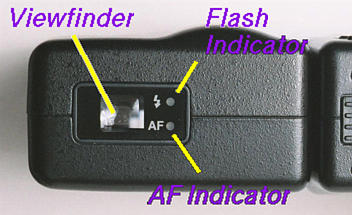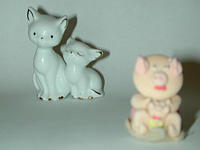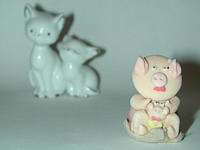Autofocus

The AF Indicator
When the mode dial is turned to position
A-REC, the camera is
in the program and autofocus mode. To activate autofocus, point the camera
to your subject and press the shutter release button halfway down, if the
AF indicator on the back panel of
the lens unit turns on, the camera has been successfully focused on your
subject; otherwise, the AF indicator
blinks, which means the camera fails to focus on your subject.

|
|
Viewfinder, Auto-Focus (AF) indicator and flash indicator
|
In the AUTO mode, the flash indicator turns
on if it will fire when the shutter release is tripped.
Click here to learn more about the
AUTO mode of the built-in flash.
Viewfinder and LCD Monitor
There are two ways of composing your photograph. The first one is through the
use of the viewfinder (see photo above), which is in the back side of the lens unit.
In this case, you should make sure the subject you want the sharpest is in the
focus bracket [ ]. Or, you can use the LCD
monitor. If the LCD monitor displays nothing, keep pressing the
MONITOR button until
an image appears. If the LCD monitor still displays nothing after
pressing the MONITOR
button several times, it is likely that the batteries have run out of power.
So, check batteries and use a new set if necessary.
Close-Up
The default autofocus mode does not work very well
when your subject is closer than one foot. If the distance
between the camera and your subject is less than one foot, the
AF indicator blinks, indicating an
autofocusing problem. If this happens, you should consider to use the
close-up mode. Click here to see the
details.
Distant Subjects
Sometime, the AF indicators also blinks
when you are taking a distant scenic view. If this happens, you should
use the infinity mode. Click here
to see the details.
Focus Lock
In some situations, it is difficult to focus correctly for your
composition. For example, you want to take a photograph of your friend who
is in front a big building (e.g., the Notre Dame). If you focus on
the building, the building becomes the sharpest part of your photograph and
your friend could be out-of-focus. On the other hand, if you focus on your
friend, your friend will be sharply focused; but the building could be a
little blur. If this does happen, you should pick the subject you
want to sharply focus. Then, follow the procedure below:
- Point the camera to your main subject
- Press the shutter release button halfway down and make sure the
AF indicator turns on.
Please still hold the shutter release button. The focus is
locked.
- Now recompose your photograph, and press the shutter release
button all the way down to take the photograph.
The following photographs have two small subjects. It is difficult to
take a photograph with both subjects sharply focused. If the far subject
is the main one, we can focus on it by pressing and holding the shutter
release button halfway down, recomposing, and pressing the shutter release
button all the way down to take a photograph. The result is the left
photograph. It is clear that the near subject is not focused. The right one
shows the result of choosing the near one as the main subject. In this case,
the far subject is not in focus.

|

|
|
Far main subject
|
Near main subject
|
|
Click on the picture to see a full size
one
|
Difficult-to-Focus Subjects
Autofocus cameras usually fails if you aim them at the following subjects:
- Low-contrast subjects such as the blue sky, highly reflective
surfaces like shiny cars or water, and single-color wall.
- Subjects with continuous and repeated patterns.
- Both near and far subjects are at the same time within the
autofocus bracket.
- Strongly backlit subjects or those having a bright shiny background.
If the camera fails to focus, the focus lock feature might overcome this
situation. First, find a reference subject which is at about the same
distance to the camera as your main subject;
second, focus on this reference subject and
lock the focus (i.e., press the shutter release button halfway
down and hold it there); and third, recompose your photograph and
press the shutter release button all the way down to take a
photograph.
Viewfinder vs. LCD Monitor: A Few Notes
Both viewfinder and LCD monitor can be used for focus and composition.
Which one is better? Here are a few important notes:
- The LCD monitor consumes more battery power. Moreover,
when the LCD monitor is on, autofocus
is always on and continues to focus. You can hear the
noise generated from the focusing motor inside the lens unit.
Although the LCD monitor is shot-down if it is not being used for
a while, both the LCD monitor and the focusing motor can consume
too much battery power. Therefore, either turn off the LCD monitor
(i.e., press the
MONITOR a few times until the LCD monitor displays
nothing), or turn off the camera when it is not being used.
- Both the viewfinder and the LCD monitor do not provide you with
the "what you see is what you get" result. The image area is
actually larger than what you see on the viewfinder and the
LCD monitor. The LCD monitor shows about 95% of the actual image,
while the viewfinder only shows 85%. In terms of viewing area,
the LCD monitor is definitely more accurate. Moreover, the
viewfinder and LCD monitor
do not show the same area!
Both are slightly offset in opposite directions relative to the
actual image.
- You have difficulty to see the LCD monitor under bright sun light.
The image is almost washed out. The
Hoodman LCD monitor hood could be very useful to remedy
part of this problem. On the other hand, you can always
use the viewfinder. Is this an advantage of using the viewfinder?
Not really. When you use the
wide angle converter or the
tele converter, half of the
viewing area in the viewfinder is blocked.

